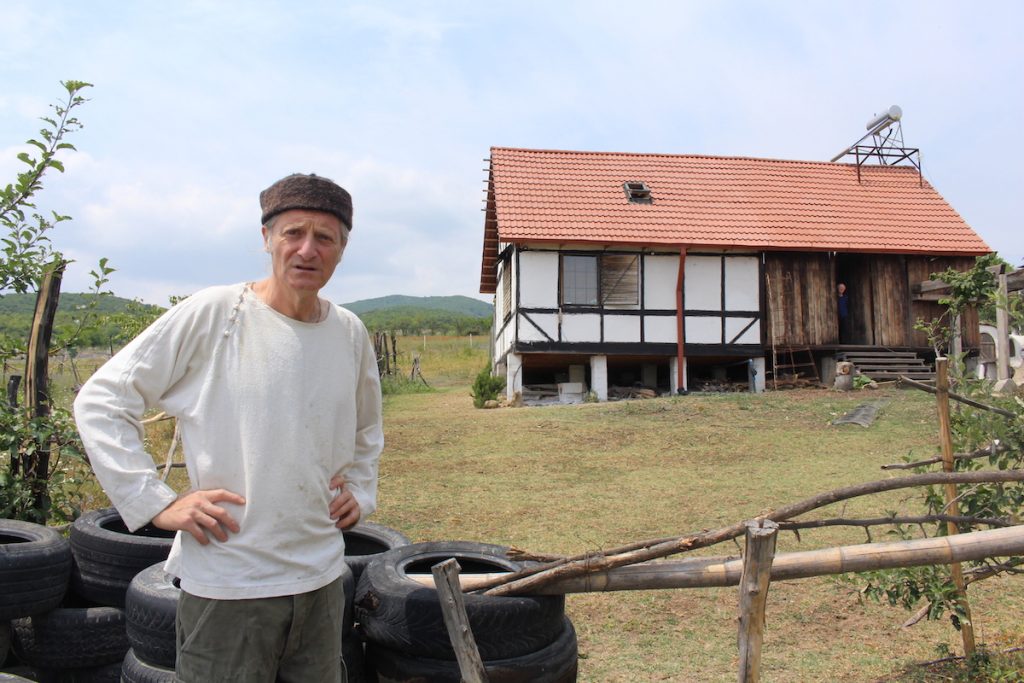
By MARIA DRAGONOVSKA, JAM-NEWS.NET
BAKURTSIKHE, Georgia
When I go to the other World, I want nothing left behind, says David Chachanidze. He and his wife Tina Samadashvili live in a rural house in Georgia made mostly out of straw bales.
The straw house home to David Chachanidze and Tina Samadashvili is reachable after a two-kilometre hike uphill from the village of Bakurtsikhe, amid the wine country of eastern Georgia’s Kakheti region.
Construction and demolition waste frequently take up to 30 per cent of landfills content the world over. If we don’t want landfills full of concrete, we need to think about ways to recycle such waste or not create it.
Chachanidze, a medical doctor, is among the few in Georgia dealing with this problem personally. Together with his architect wife, they’ve built three houses completely out of natural local materials – mainly wood, lime, earth, and straw bales.
Given that all the materials are organic, such structures naturally decompose in just a single year. Building houses out of natural materials is not only out of environmental but also health motivations.
As an M.D., David Chachanidze explains that living in a house may help his own health problems like allergies or intestinal infections.
ESCAPE FROM THE CAPITAL
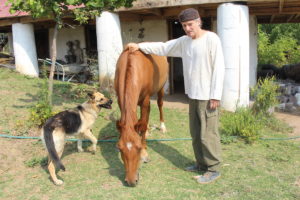
Six years ago, life changed completely for David and Tina. They made a radical move – out of the capital, Tbilisi, to Bakurtsikhe, to make and live in their house.
“I think that when people become older, they need to put their feet on the soil, not on the concrete blocks of high rises,” he says.
Add the COVID-19 pandemic, and Chachanidze realised he did not need to live in the city after all.
“You can do business anywhere. I make cosmetics for the skin with natural materials. I can sell them on the internet. I have consultations with my patients over the internet. My wife also sells her own self-designed furniture online”, he explains.
The couple keeps a horse, three dogs and a few cats, who inhabit the garden around the house.
Initially, their idea was to buy a house in the countryside. But the offerings were short of their expectations: They were ecologically unclean, lacking comfort, not cool enough in summer, and not warm enough in the winter.
“All those buildings were very strange – the old ones were wrecks, made out of awful materials such as concrete blocks or asbestos.
“The ground floors were damp and full of mould. They smelled like mushrooms”.
According to him, such synthetic materials absorb humidity and promote mould growth.
“The other floors were empty and very cold with no heating,” he added.
“That’s why we decided to build a house ourselves. We’ve spent four years researching how people build eco-friendly houses all around the world.”
Finally, they bought a land plot in Bakurtsikhe. It took one year and 6,000 Georgian lari ($1,935) at current construction costs for their straw home.
The couple decided on a house made of straw bales, as straw is very cheap and easy to get in the predominantly rural Kakheti region.
Aside from the straw base materials for walls, they added wood and clay from their own garden.
The couple concocted an egg and milk mixture as a homemade plaster.
“This house can stay up for 700 years, like the Charles Bridge in Prague, where they also used eggs and milk in the plaster, but when deconstructed and left in the sun and rain, it decomposes in only one year – which I think is good.
“We came onto clean land, and we should leave it clean when we are gone.”
FEWER FIRE WORRIES
The house is relatively fireproof due to the 5-cm layering of the egg-and-milk plastering and high compression of the straw walls.
“There is no oxygen inside the walls, and that is why it is safe,” explains Chachanidze.
Chachanidze and Samadashvili have turned to building houses based on straw bales for a living.
“The first house was an experiment, and we made many mistakes – for example, using clay for plastering. We got all the information from books, but clay in the U.S. is not the same as in Georgia. The plastering starts to crack,” says Chachanidze.
“In the second house we built, we used lime from Rustavi [near Tbilisi], and so far, it works great.”
INSPIRED BY LEONARDO da VINCI
With straw bales, it is also easier to get creative with design styles and shapes.
The second house the couple constructed is less utilitarian and more artistic – a real masterpiece.
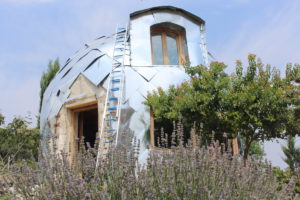
It is shaped hyperbolically and covered in sheet metal plates for better insulation. The couple draws the design from Leonardo da Vinci’s plans.
“It is an organic spherical architecture. We were going for the woman’s womb, which is shaped like a sphere. It is an optimal structure for energy circulation, vital energy, and heat,” he said.
“Inside, the air is cool, though the air is hot outside. And in the winter, it will be warm inside because straw is a great insulator.”
The floor – foundation – is another unique feature and insulator.
The couple used 2,500 old glass bottles to create it.
The second house is made in the form of wooden triangles and hexagons, allowing for a round shape.
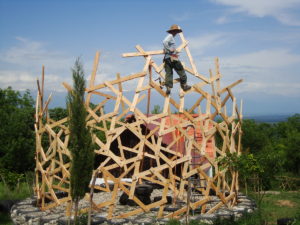
“Of course, it was difficult to build because you need to know mathematics and geometry very well. It’s like a puzzle. My wife and I are a good team.
“She is an architect. I am like an idiot, but in a good way, like Forrest Gump. When I started building these houses, I did not understand what I was doing.
“I just did everything she told me to do because as an architect, she could see the end result of the structure. I do the mechanical part, and we are learning together. We had to disassemble everything five times before we managed to get it to the point how it looks today.”
MAGNET FOR CURIOSITY SEEKERS
The word is out, and now people are coming to David and Tina´s houses to see for themselves.
Some of them, mostly foreigners, even stay and help the couple with the building process. Apart from the two finished dwellings, they are making a third: one constructed out of bags of soil to serve as a stable.
Another house is being built by his children, just outside Tbilisi. According to Chachanidze, anyone who is really interested is capable of building one.
“After ours, three more people started building houses out of straw bales. Maybe they will be even better because our mistakes will not be repeated.”
“There was one guy who came by. I showed him everything, then he said: ‘Ok, I understand’. He then went and built the house by himself.”
ASSESSING THE PROS AND CONS
The second house cost just 4,000 lari ($1,290), most of the work also done by the couple themselves.
Environmental issues are an obvious advantage for a straw-bale house. The straw itself is actually a waste material. Only straw not used as agricultural or livestock material is put to use in their constructions.
But there are other considerations, more practical. As straw is a great insulator, there is not that much energy needed to heat the house in winter or keep it cool during the hot Kakhetian summers.
Including straw, plaster, and wood, the walls are a hefty 30 cm thick. This protects the structures from the sun, which can overheat the dwellings.
The low cost of the materials is also very tempting.
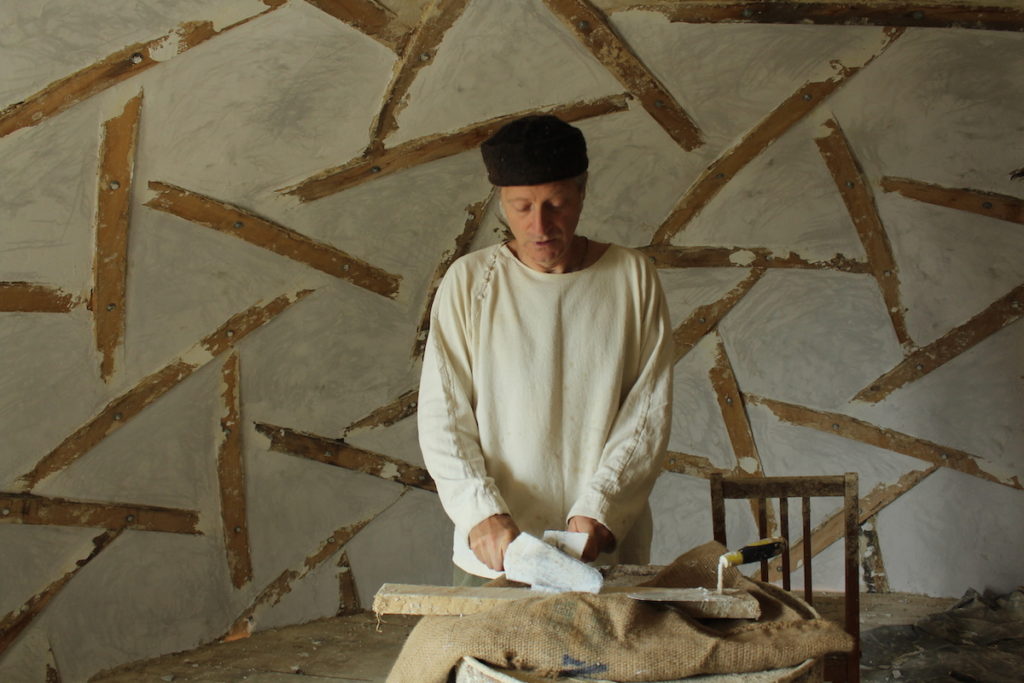
At the same time, there are some disadvantages, the couple points out.
As the walls need to be quite thick, a similar brick house would leave more interior space.
Using straw as a construction material is also not recommended in areas of high humidity. Once wet, straw may never completely dry out.
This can also cause the growth of mould and fungi. If not checked, it could lead to a structural collapse.
But David and Tina have taken all of this into account.
“We´ve built a long drainage pipe system, which provides us with some water from the forest nearby. That is enough for washing, but still, there can be a shortage in summer, and the water is not potable.
“We need to buy clean water, and the only way is to buy it is in big plastic bottles. As we try to be conscious about plastic waste, we then use the plastic bottles as flower pots”.
For the future, Chachanidze wishes to become completely self-sufficient. As soon as he finishes the second house, he plans to put all his force into a fruit and vegetable garden to provide fresh, organic food for his family.
He is also diversifying his medical skills. He works as a homoeopathic doctor and does not ask his patients for money. Instead, they bring him eggs, milk, or other homemade products in barter.
He also wants to turn to beekeeping. “We want to use the space around our house and teach people how to care for bees”.
According to Chachanidze, for older people, working in a field is very challenging physically. But working with bees is manageable. And bee products – honey, creams, pollen – are known to have health properties for older people.
“We really want to take care of the bees and plant the trees to create an ecosystem that is suitable for this place – for people, animals, and the environment.”
THIS ARTICLE WAS PRODUCED BY JAM-NEWS.NET AND REPRINTED WITH THEIR PERMISSION. THE TRIBUNE EXPRESSES ITS SINCERE THANKS TO JAM-NEWS.NET
JAM-NEWS.NET offers the latest news about the developments in the region, reporting exclusively verified data. We offer professional and impartial analysis on the major trends and developments, thus seeking to help people from different regions of the Caucasus to get to know each other better.
